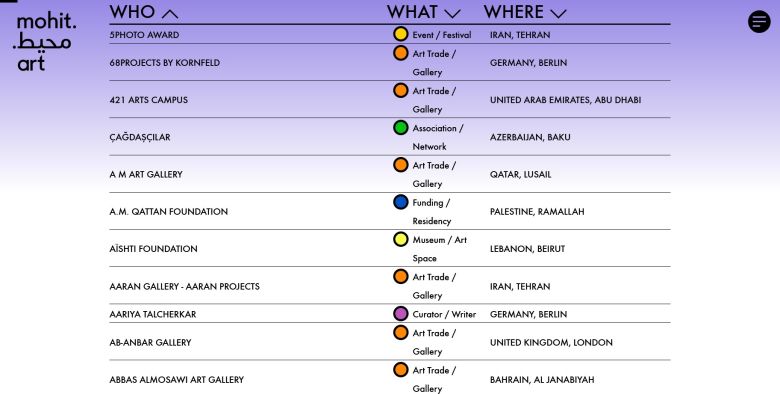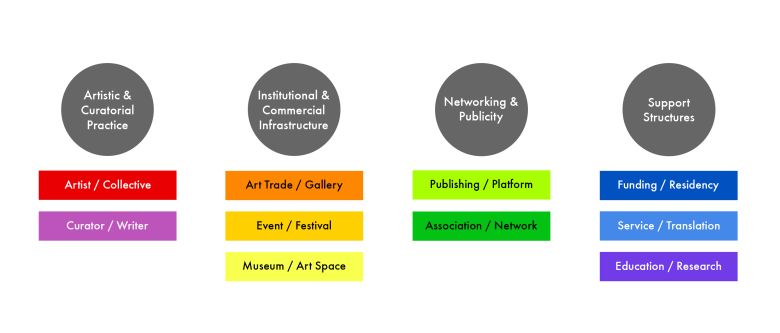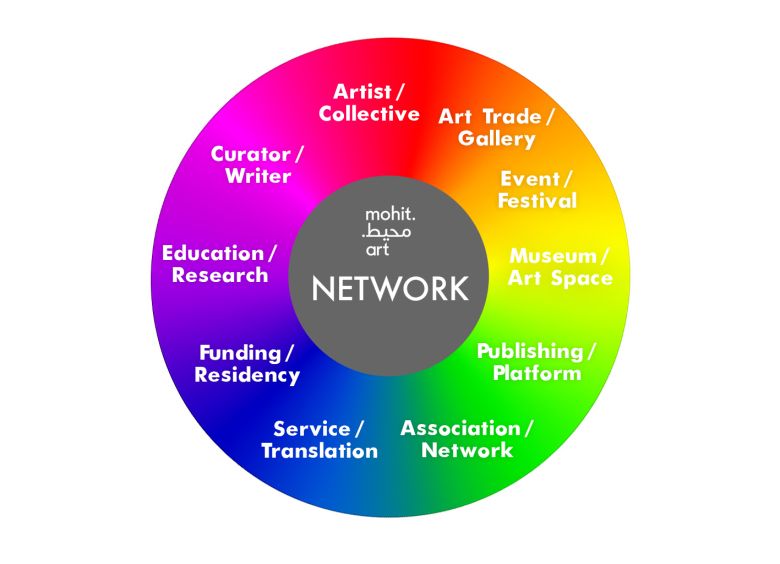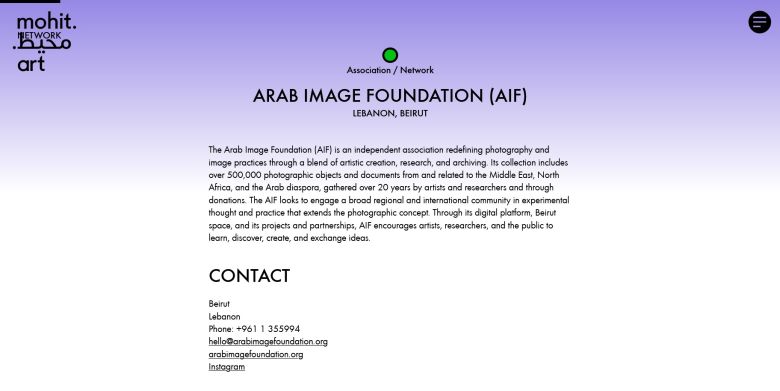The people across the Southwest Asian region are facing an alarming escalation of violence, with devastating consequences for artists, curators, and those working in contemporary arts. In countries like Iran, Palestine, Lebanon, Syria, and Afghanistan, entire generations of artists and creative practitioners are grappling not only with threats to their lives, displacement, and instability but also with the erasure of their narratives from global art discourse. Yet the centers of the global art market — from Basel to New York — remain largely unaffected by what’s unfolding in this region, still operating under a mindset that defines “global” art through exclusion and prestige.
Art made in the face of these challenges is resistance and testimony; it offers space to grieve and aids in survival. Crucially, it´s rooted in long-standing cultural and political histories.

mohit.art supports the voices of artists, cultural actors and organizations from Southwest Asia and North Africa (SWANA) and their diasporas precisely at a moment when they are increasingly threatened . That is why we are now growing and transforming the mohit.art NETWORK — not simply by adding entries but by changing how the network works. Starting now, in July 2025, independent voices and institutions from and linked to the region can actively shape it: by editing existing profiles, publishing new ones, and growing the ecosystem from within.
mohit.art remains the only organization building a curated, open-access network that connects artists, collectives, curators, writers, galleries, festivals, associations, and supporting individuals from SWANA and its diasporas. We aren’t just publishing content — we are now handing over the tools, enabling visibility, access, and autonomy to emerge from within the network itself.
Refusing silence, our response to the machinery of war is the daily work of taking up roles that expand “mohit” — the field that surrounds, connects, and sustains. Each profile on the NETWORK is a declaration of presence, each new entry, a tactic against fragmentation.
The mohit.art NETWORK is structured as a tool for solidarity and visibility. It maps ten kinds of artistic and cultural work across four primary domains: Artistic & Curatorial Practice, Institutional & Commercial Infrastructure, Networking & Publicity, and Support Structures.
Mapping the arts is not an abstract classification — it is a political act . We center not only artists but also those in the art field who write, research, translate, publish, host, fund, sell, collect and sustain. Cultural ecosystems do not endure through creativity alone; they rely on care, access, and shared tools.

The NETWORK’s structure follows no hierarchy. It is designed as a living mesh, where roles overlap, relationships multiply, and interdependence replaces prestige. The NETWORK is also not a list — it is a fabric: flexible, responsive, and collectively held.
Rather than offering solutions from above, it creates space for complexity. It stays with the trouble — with displacement, fragmentation, and historical rupture — not to resolve it, but to persist through it, with patience and care.
The NETWORK also embraces in-between spaces — between languages, identities, and geographies. It grows in the borderlands: between exile and belonging, visibility and erasure, tradition and reinvention. The mohit.art NETWORK thrives where fixed definitions fail.
Each category is color-coded with intent — not to sort, but to connect. Artists who teach, curators who write, collectives that fund: all find space here. The structure reflects a field shaped by urgency, collaboration, and transcultural presence.

In today’s art field, institutional and commercial infrastructures have the most visibility — especially in the gallery and art-trade sectors. These are followed closely by museums and art spaces, alongside a strong community of independent artists and collectives.
Associations and networks act as key connectors across regions and practices. Funding bodies and residency programs form another crucial pillar, shaping mobility, time, and sustainability.
This diverse, interdependent ecosystem — crossing people, places, institutions, and platforms — gives the mohit.art NETWORK both its form and its force. It is not only a reflection of how art is made public but a blueprint for cultural survival and solidarity, practiced every day.
The mohit.art NETWORK is a solidarity-driven system that sustains cultural visibility where it is most under threat. To support artists, collectives, and institutions across the SWANA region working under unequal conditions, we are introducing flexible profile options, including both free and paid plans, as after October 2025. Users can decide how they wish to appear in the network, with free basic listings always available and additional premium tools an option for greater reach. The standard, no-cost profile includes all essential details, and paid premium features include images, video, social media links, mohit.art CALENDAR listings, and newsletter placement. This way, members can adapt their listing to their current situation while ensuring the platform remains open to all and resilient for communities at risk of exclusion.

The mohit.art NETWORK first took shape in 2021 through strong participation from members in Germany, France, the Netherlands, and other parts of Europe alongside a dense constellation of artists, institutions, and initiatives from Iran. These starting points were not arbitrary but responded to overlapping urgencies: exile, repression, diaspora, and creative resistance.
From this foundation, the network has since expanded across the SWANA region — with around 700 profiles already live and active contributions from Lebanon, the United Arab Emirates, Iraq, Jordan, and Azerbaijan. Connections now extend to Qatar, Bahrain, Saudi Arabia, Syria, Afghanistan, Israel, and Palestine — contexts where visibility is often limited by political conditions or conflict, or shaped by systems of apartheid and exclusion.
Further nodes are emerging: from Morocco and North Africa to diasporic initiatives in the Americas, especially in places where transcultural practices cross languages, affiliations, and borders.
The mohit.art NETWORK grows from the ground up: it will be shaped by its users — artists, curators, collectives, galleries and museums — who can create and manage their own profiles. We provide the tools to make that possible. This is not a top-down platform, but a shared space for visibility, continuity, and connection.
Yet openness does not mean anything goes. What makes the NETWORK meaningful is the quality of its content — the strength, rigor, and depth of the artistic and cultural work that fills it. The contemporary art scenes of Southwest Asia, North Africa, and their diasporas are often underrepresented — but they are not marginal in quality. Quite the opposite: they are intellectually bold, aesthetically rich, and deeply relevant to global discourse.
That is why participation in the NETWORK is based on a clear curatorial framework. Profiles are reviewed, and not all are accepted. This is not gatekeeping, but care — care for the field, for context, and for the power of art to speak clearly across borders and continents.
We welcome many languages, practices, and positions. But we ask that each entry shows artistic intent, authorship, and connection to a larger ecosystem. The NETWORK is a tool for shared presence — and quality is the key to its strength.
We see the user generated mohit.art NETWORK as a cultural and political initiative in times of war, violence, and forced migration. We build not to claim territory but to hold space: for those from and those working in SWANA between legitimacy and loss, in cultural environments shaped by fragmentation and urgency. The NETWORK is a who-is-who directory, but its also more: It becomes a strategy for resilience — a shared platform for presence — wherever it risks being erased. By extending the NETWORK, we build an important terrain of resistance through contemporary art — one that can’t be bombed, banned, buried, or forced to exile. This is our barricade against silence, a collective frontline.
Our latest updates to the mohit.art NETWORK have been made possible by a brilliant team and is guided by a growing network of regional ambassadors and collaborators.
Summer 2025 — The ability for users to update their existing entries or create new ones on the fully launched user-generated platform.
Autumn 2025 — Expanded presentation and visibility options, offering additional tools and features for those who need greater reach while maintaining free standard profiles for everyone.
Ongoing — Tutorials, workshops, and social campaigns to support and amplify transcultural voices.
The mohit.art NETWORK is becoming a living infrastructure of solidarity — a lighthouse for excellence, visibility, and connection in times of rupture and reinvention.
We invite you to join.
REGISTER
network@mohit.art